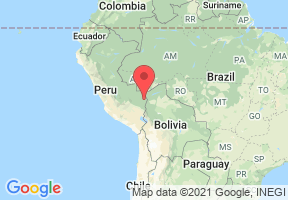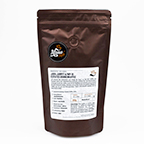

PERU TUNKI BIO - Bohnenkaffee
Tunki is a beautiful, colourful bird inhabiting the high Andes' forests. Unsurprisingly, the farmers of Peru's Tambopata Valley named their plantation Arabica after it. Experiencing this coffee is as delightful as seeing a Tunki bird. A subtle hint of lime beautifully complements the sweetness of the milk chocolate that is prominent. Much like a bird's feather, this coffee is light, and like a bird's song, it is graceful.
Zusammensetzung
Arabica BIO 100%Crema and flavour of the coffee
The Peru Tunki BIO coffee beans capture South American coffee's sweetness, complexity, and harmony. Thanks to the medium roast, milk chocolate, and molasses notes stand out, which are gently accentuated by a drop of lime juice. The crema is light, compact, and smooth.
Origin of the coffee
Peru, South America Tambopata, one of the wildest places in Amazonia. If you ever go to Peru, definitely visit this area. The Reserva Nacional Tambopata, a nature reserve established in September 2000 by President Alberto Fujimori's decree, will take your breath away. The untouched landscape, the size of the US Yosemite National Park, is covered in rainforest, intersected by many meandering rivers, and inhabited by hundreds of thousands of species of flora and fauna. Lakes, wild beasts, colourful birds, rare plants. You will find it all in Tambopata. And nearby, of course, are the coffee plantations.
The farms are usually situated at around 1,700 metres above sea level, taking advantage of the mountain weather and fertile soil. However, it is very difficult for plantation owners and workers to get to their bushes - they often have to make quite a trek both to the plantation and to the port to harvest. In such conditions, they let the bushes grow as naturally as possible without the use of fertilizers or pesticides. However, all the sacrifice is compensated for by the great result of their efforts - plantation arabica of unforgettable taste.
For the local farmers, mostly members of the indigenous Quechua and Aymara tribes, it is advantageous to be cooperative members. Each family runs a small farm of around two hectares. When farmers join together, they can harvest, process, and market their coffee faster and better.
As you might guess, in the high Andes, coffee is only hand-combed. Once the coffee cherries are brought down to the processing plants by workers, they are mechanically de-skinned in mills and then left to ferment for several hours. The released green coffee beans must finally be dried, spread out on terraces under direct sunlight, packed, transported, or taken away for sale. The result is top-quality coffee for which customers do not hesitate to pay a premium price. That is also why farmers manage to maintain a decent annual income, regardless of fluctuations in world coffee prices.
Beispiel für die Kaffeeverpackung
Unser Kaffee ist einer hochwertigen Aluminium-Verpackung verpackt, die keine auffälligen graphischen Elemente hat, weil es in unserer Firma vor allem um den Geschmack und um die Qualität geht. Die echte Frische von unserem Kaffee können Sie auch anhand des Ventils überprüfen, das die Gase, die nach dem Rösten entstehen, freisetzt. Hochwertige Packung, die den Charakter des Kaffees bewahrt. Der Kaffee ist in der Verpackung immer hermetisch verschlossen, damit er resistent gegen Feuchtigkeit, Licht und fremde Gerüche ist.
Zubereitung:
- Grind the coffee to a coarseness appropriate for this type of preparation.
- Use 1.5-2 teaspoons (approx. 7 g) of ground coffee for each cup.
- Pour on water (95°C).
Brauchen Sie Hilfe?









 GLS
GLS DHL
DHL

